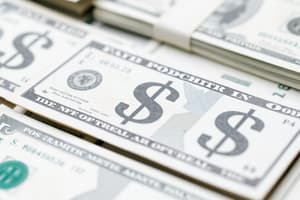Podcast
Questions and Answers
Which of the following best describes the primary characteristic of a cash equivalent?
Which of the following best describes the primary characteristic of a cash equivalent?
- It is short-term, highly liquid, and easily convertible to a known cash amount. (correct)
- It is restricted by legal requirements for a specific purpose.
- It is a long-term investment with significant risk of value fluctuation.
- It represents the minimum cash amount required to be maintained in a bank account.
A company has $50,000 in its checking account but is required to maintain a minimum balance of $10,000 as per their loan agreement. How should these amounts be classified on the balance sheet?
A company has $50,000 in its checking account but is required to maintain a minimum balance of $10,000 as per their loan agreement. How should these amounts be classified on the balance sheet?
- \$40,000 as cash and \$10,000 as a non-current asset.
- \$40,000 as cash and \$10,000 as restricted cash. (correct)
- \$50,000 as cash.
- \$50,000 as restricted cash.
Which of the following activities is classified as an investing activity on the statement of cash flows?
Which of the following activities is classified as an investing activity on the statement of cash flows?
- Purchasing equipment for use in operations (correct)
- Paying dividends to shareholders
- Repurchasing company stock
- Issuing bonds to raise capital
A company's bank statement shows a balance of $15,000, while its cash account shows $12,000. There is a $4,000 deposit in transit and $1,000 of outstanding checks. What is the reconciled cash balance?
A company's bank statement shows a balance of $15,000, while its cash account shows $12,000. There is a $4,000 deposit in transit and $1,000 of outstanding checks. What is the reconciled cash balance?
Under the indirect method of preparing the statement of cash flows, how is depreciation expense treated?
Under the indirect method of preparing the statement of cash flows, how is depreciation expense treated?
Which activity is classified as a financing activity on the statement of cash flows?
Which activity is classified as a financing activity on the statement of cash flows?
What is the primary difference between the direct and indirect methods of preparing the statement of cash flows?
What is the primary difference between the direct and indirect methods of preparing the statement of cash flows?
Which of the following is an example of a significant non-cash investing and financing activity that would be disclosed in a separate schedule or notes to the financial statements?
Which of the following is an example of a significant non-cash investing and financing activity that would be disclosed in a separate schedule or notes to the financial statements?
Why is preparing a cash budget important for effective cash management?
Why is preparing a cash budget important for effective cash management?
A company wrote a check for $2,500 when its account balance was $1,000. How should this $1,500 overdraft typically be classified?
A company wrote a check for $2,500 when its account balance was $1,000. How should this $1,500 overdraft typically be classified?
How do changes in current assets and current liabilities impact the cash flows from operating activities under the indirect method?
How do changes in current assets and current liabilities impact the cash flows from operating activities under the indirect method?
Which of the following reconciling items would require an adjustment to the company's book balance in a bank reconciliation?
Which of the following reconciling items would require an adjustment to the company's book balance in a bank reconciliation?
Why is proper classification of cash flows important for financial statement users?
Why is proper classification of cash flows important for financial statement users?
How does classifying restricted cash differ based on the restriction's nature?
How does classifying restricted cash differ based on the restriction's nature?
A company reports net income of $100,000. Depreciation expense is $20,000, and accounts receivable increased by $15,000 during the year. What is the cash flow from operating activities using the indirect method?
A company reports net income of $100,000. Depreciation expense is $20,000, and accounts receivable increased by $15,000 during the year. What is the cash flow from operating activities using the indirect method?
What does the free cash flow to equity ratio measure?
What does the free cash flow to equity ratio measure?
Flashcards
What is 'Cash'?
What is 'Cash'?
Physical currency, checking accounts, items easily converted to cash.
What are 'Cash Equivalents'?
What are 'Cash Equivalents'?
Short-term, highly liquid investments easily converted to cash with minimal risk.
What is 'Restricted Cash'?
What is 'Restricted Cash'?
Cash with limited use due to legal, contractual, or company-imposed restrictions.
What are 'Compensating Balances'?
What are 'Compensating Balances'?
Signup and view all the flashcards
What are 'Overdrafts'?
What are 'Overdrafts'?
Signup and view all the flashcards
What is 'Cash Management'?
What is 'Cash Management'?
Signup and view all the flashcards
What is a 'Bank Reconciliation'?
What is a 'Bank Reconciliation'?
Signup and view all the flashcards
What is a 'Cash Budget'?
What is a 'Cash Budget'?
Signup and view all the flashcards
Investing Activities
Investing Activities
Signup and view all the flashcards
Financing Activities
Financing Activities
Signup and view all the flashcards
Direct Method
Direct Method
Signup and view all the flashcards
Indirect Method
Indirect Method
Signup and view all the flashcards
Depreciation Expense
Depreciation Expense
Signup and view all the flashcards
Current Cash Debt Coverage Ratio
Current Cash Debt Coverage Ratio
Signup and view all the flashcards
Cash Debt Coverage Ratio
Cash Debt Coverage Ratio
Signup and view all the flashcards
Free Cash Flow to Equity Ratio
Free Cash Flow to Equity Ratio
Signup and view all the flashcards
Study Notes
- Cash includes physical currency on hand (coins and banknotes), balances in checking accounts, and other items readily convertible to cash
- Cash equivalents are short-term, highly liquid investments, easily convertible to known amounts of cash and subject to insignificant risk of changes in value
- Examples of cash equivalents are treasury bills, commercial paper, and money market funds
- Restricted cash has its use limited by legal requirements, contractual agreements, or company intent
- Restricted cash is classified as either current or non-current assets, depending on the nature of the restriction
- Restricted cash is classified as a current asset if restricted for current obligations, or as non-current if restricted for long-term purposes
- Compensating balances represent minimum cash amounts that must be maintained in a bank account, supporting borrowing arrangements
- Compensating balances can impact the availability of cash for company use
- Overdrafts occur when a company writes a check for more than the amount in its cash account
- Overdrafts are generally classified as current liabilities
- If overdrafts are material, they should be disclosed separately either on the balance sheet or in the notes
- Cash management involves planning, controlling, and accounting for cash transactions and balances
- Effective cash management includes preparing cash budgets and cash flow forecasts to anticipate cash inflows and outflows
- Internal controls are essential to safeguarding cash and preventing fraud/errors
- A bank reconciliation explains the differences between the cash balance reported by the bank and the cash balance per the company's books
- Reconciling items include deposits in transit, outstanding checks, bank charges, and errors
- Deposits in transit are deposits made by the company, but not yet recorded by the bank
- Outstanding checks are checks issued by the company, but not yet cashed by the recipients and cleared by the bank
- Bank charges are fees charged by the bank for services, while errors can arise from mistakes made by either the bank or the company
- The cash budget is a projection of expected cash inflows and outflows over a specific period
- Cash budgets help management ensure they have enough cash for operations and to meet obligations
- The statement of cash flows reports the cash inflows and outflows of a company during a specific period
- The statement of cash flows categorizes cash flows into operating, investing, and financing activities
- Operating activities relate to the normal day-to-day activities that generate revenue
- Investing activities include the purchase and sale of long-term assets, such as property, plant, and equipment (PP&E)
- Financing activities involve transactions with creditors and owners, such as borrowing money, issuing stock, and paying dividends
- The statement of cash flows can be prepared using either the direct method or the indirect method
- Under the direct method, operating cash flows are calculated by directly summing up all the cash receipts and cash payments from operating activities
- The indirect method starts with net income and adjusts it for non-cash items and changes in current assets and liabilities to arrive at operating cash flows
- Depreciation expense is a non-cash expense that is added back to net income when using the indirect method
- Gains and losses from the sale of assets are also adjusted for, as they are investing activities
- Changes in current assets and liabilities (such as accounts receivable, inventory, and accounts payable) are adjusted to reflect the cash effects of operating activities
- Significant non-cash investing and financing activities are disclosed in a separate schedule or in the notes to the financial statements
- Examples include the exchange of debt for equity or the acquisition of assets through the issuance of stock
- The primary purpose of the statement of cash flows is to provide information about a company's cash receipts and cash payments during a period
- It helps assess a company's ability to generate cash, meet its obligations, and fund its investments
- Investors and creditors use the statement of cash flows to evaluate a company's financial health
- It shows how the company is managing its cash resources and whether it is generating enough cash to sustain its operations and growth
- Analyzing cash flow patterns can reveal trends and potential problems, such as declining cash from operations or excessive borrowing
- Certain financial ratios can be derived from the statement of cash flows to assess a company's liquidity and solvency
- The current cash debt coverage ratio indicates a company's ability to meet its current liabilities with its cash from operations
- The cash debt coverage ratio measures a company's ability to repay its total debt with its cash from operations
- The free cash flow to equity ratio measures the cash available to equity holders after all obligations have been paid
- Free cash flow represents the cash flow available for discretionary purposes, such as paying dividends or making acquisitions
- Proper classification of cash flows is essential for accurate financial reporting and analysis
- Misclassifying cash flows can distort financial ratios and mislead users of the financial statements
- An example of misclassification is classifying interest paid as an operating activity for some companies and a financing activity for others
Studying That Suits You
Use AI to generate personalized quizzes and flashcards to suit your learning preferences.




